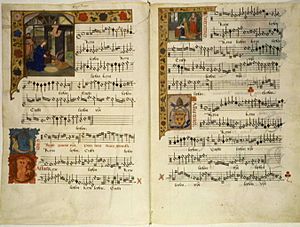Mass (music) facts for kids
In music, a mass is a special type of musical piece. It is usually sung by a choir in churches like the Roman Catholic, Anglican, and Lutheran churches.
There are two main kinds of masses:
- The Ordinary mass uses the same songs and words all year round. It is not connected to specific dates on the church calendar.
- The Proper mass has parts that change throughout the year. These parts are different depending on the church season or special day.
Long ago, masses were often sung in Latin or Greek. Some famous masses not in English include the Deutsche Messe by Franz Schubert and A German Requiem by Johannes Brahms.
Contents
What are the Parts of a Mass?
A musical mass is made up of different sections. These sections use specific words from a church service.
The Ordinary
The Ordinary refers to the words of the mass that are always the same, no matter the day. These words are set to music. The Ordinary has five main parts:
- Kyrie: This means "Lord, have mercy upon us."
- Gloria: This means "Glory be to you."
- Credo: This means "I believe in God the Father."
- Sanctus: This means "Holy, Holy, Holy."
- Agnus Dei: This means "O Lamb of God."
The Proper
The Proper refers to the words of the mass that can change from day to day. These words are special for certain church days or celebrations. The Proper includes parts like the Introit, Gradual, Alleluia, Tract, Offertory, and Communion.
History of Mass Music
During the Renaissance period (from about the 14th to the 17th century), church composers wrote music for the words of the Ordinary mass. This music was often polyphonic. This means that different parts of the choir, like soprano, alto, tenor, and bass, all sang their own musical lines. These lines were equally important and shared the melody.
The words of the Proper were usually not set to new music. Instead, they were sung using plainchant. Plainchant is a very old style of singing with a single melody, without harmony.
Masses for Concerts
In the last two hundred years, many composers have written masses that are not meant for a church service. Instead, they are written to be performed in concerts. Some of these pieces are very long and can fill an entire concert program.
Some of the most famous composers who wrote masses include:
Related pages
See also
 In Spanish: Misa (música) para niños
In Spanish: Misa (música) para niños


